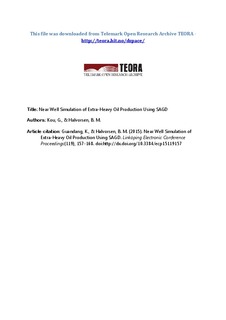Near Well Simulation of Extra-Heavy Oil Production Using SAGD
Conference object, Peer reviewed
Published version
Permanent lenke
http://hdl.handle.net/11250/2438482Utgivelsesdato
2015-11-25Metadata
Vis full innførselSamlinger
Originalversjon
Kou, G., & Halvorsen, B. M. (2015). Near Well Simulation of Extra-Heavy Oil Production Using SAGD. Paper presented at the 56th Conference on Simulation and Modelling (SIMS 56), October, 7-9, 2015, Linköping University, Sweden. doi:http://dx.doi.org/10.3384/ecp15119157 http://dx.doi.org/10.3384/ecp15119157Sammendrag
Heavy oil and bitumen represent a massive world resource more than twice the size of global reserves of light or conventional oil. In reservoirs with extra heavy oil and bitumen, thermal methods are used to reduce the oil viscosity, in order to extract the oil. Steam-Assisted Gravity Drainage (SAGD) is a thermal method where continuous steam injection is used. In this method, two horizontal wells are placed in parallel. Different types of inflow control technologies are developed to increase oil recovery by avoiding production of unwanted fluids, and the newest on the market is an autonomous inflow control valve (AICV). In the SAGD processes, it is important that the residence time for steam is high enough to ensure that the injected steam condenses in order to utilize all the latent heat. The AICV technology has the ability avoid steam to be produced together with the oil. The valves will locally shut off the zones with steam breakthrough, and simultaneously produce oil from the other zones along the well. The technology eliminates the steam breakthrough problems and contributes to optimize the SAGD process. Reservoir simulations with Rocx in combination with OLGA are performed to study the potential of increased oil recovery using SAGD in combination with AICV completion. TechPlot is used to study the reservoir conditions. The results are discussed regarding oil recovery, residual oil saturation and optimization of steam injection.
